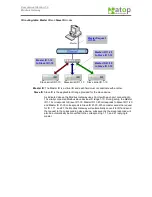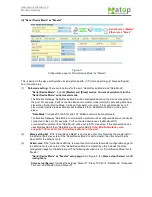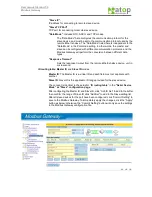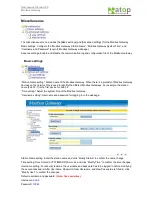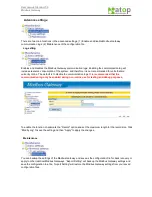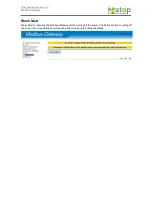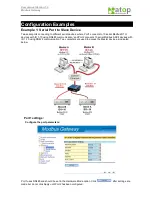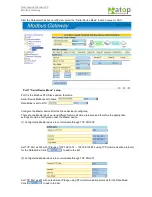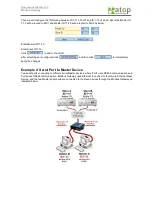
User manual Version 1.0
Modbus Gateway
(II) “Serial Device Mode” as “Master”
Figure 2.
Configuration page for “Serial Device Mode” as “Master”
This is similar to the slave configuration including three parts, (1) Port-mode setting, (2) Slave-setting list,
and (3) Action area.
(1)
Port-mode setting
: There are to options for the port, “Serial Device Mode” and “Data Mode”.
“Serial Device Mode”
: Includes
[Master] and [Slave] modes. Current description is for the
“Serial Device Mode” under master mode
.
The Modbus Gateway “Serial Device Mode” will be configured based on the device connected to
the port. For example, Port1 connected device is in master mode (mainly for accessing data from
slave) then “Serial Device Mode” will be set to master; vise versa, if the connected device is in
slave mode (mainly provides data access for Master) then “Serial Device Mode” will be set to
slave.
“Data Mode”
: Includes RTU, ASCII, and TCP Modbus communication protocols.
The Modbus Gateway “Data Mode” communication protocol will be configured based on the device
connected to the port. For example, Port1 connected device uses the Modbus RTU
communication protocol then “Data Mode” will be set to RTU; vise versa, if the connected device
uses Modbus ASCII then “Data Mode” will be set to ASCII.
Note: Modbus Gateway also
supports TCP mode for the “Serial Device Mode” at the port.
(2)
Slave-setting list
: If the “Serial Device Mode” is set to slave, then this list will be the master list for
the Ethernet port; vise versa, if the “Serial Device Mode” is set to master, then this list will be the
slave list for the Ethernet port.
(3)
Action area
: If the “Serial Device Mode” is slave then this includes the master configuration page for
the Ethernet port; vise versa, if the “Serial Device Mode” is master then this includes the slave
configuration page for the Ethernet port. The following description is for “Serial Device Mode” set to
“Master”.
“Serial Device Mode” as “Master” setup page
: As in Figure 2. the
Slave setup (Server)
and
ID
routing table
.
Slave setup (Server)
: Includes the settings “Slave IP”, “Slave TCP Port”, “Data Mode”, “Response
Timeout”, and “Master ID and Slave ID”.
Serial Port as “Master”
Ethernet as “Slave”














